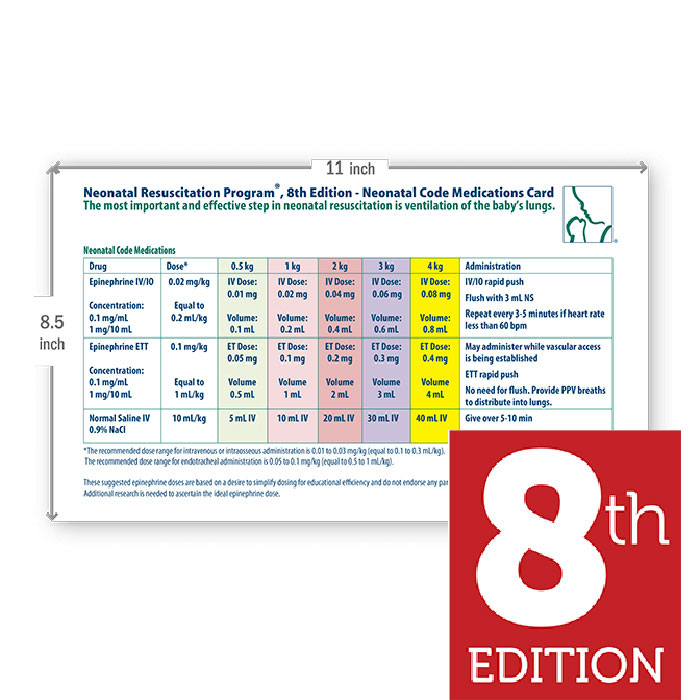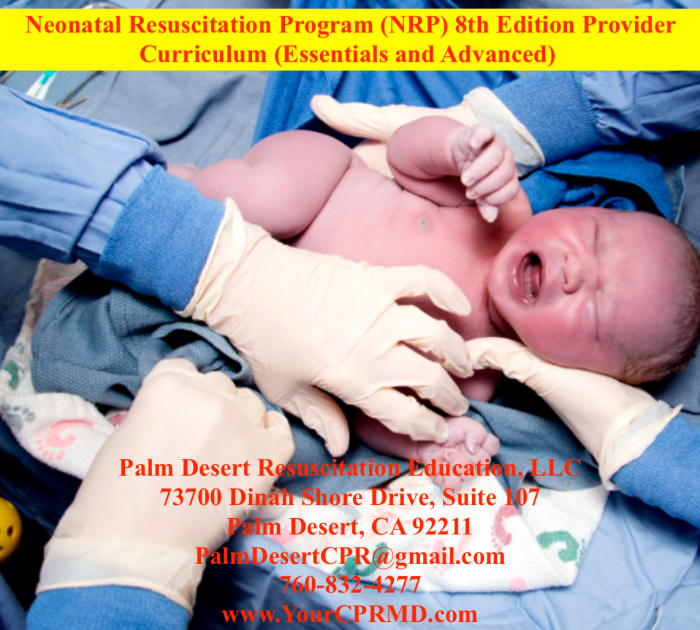NRP Epi Dose 8th Edition: A Comprehensive Guide for Neonatal Resuscitation. This 8th edition of the Neonatal Resuscitation Program (NRP) introduces significant updates and changes, making it essential for healthcare providers to stay informed about the latest guidelines for administering epinephrine to neonates.
This guide provides a comprehensive overview of the NRP 8th edition epi guidelines, including indications for epi administration, dose calculation, administration techniques, monitoring, and management after epi administration. It also covers special considerations for specific patient populations and emphasizes the importance of ongoing education and training.
NRP Epi Dose 8th Edition Overview

The 8th edition of the Neonatal Resuscitation Program (NRP) represents a significant update to the guidelines for the resuscitation of newborn infants. This edition incorporates the latest evidence-based practices and research findings to provide healthcare professionals with the most up-to-date information and recommendations for neonatal resuscitation.
Key Updates and Changes
- Emphasis on teamwork and communication:The 8th edition highlights the importance of effective teamwork and communication among healthcare providers during neonatal resuscitation.
- New algorithm for meconium aspiration:The algorithm for meconium aspiration has been revised to reflect the latest evidence and best practices.
- Updated guidelines for the use of epinephrine:The 8th edition provides updated guidelines for the administration of epinephrine in neonates, including the recommended doses and indications for use.
- Emphasis on post-resuscitation care:The 8th edition places a greater emphasis on the importance of post-resuscitation care, including the assessment and management of newborns who have experienced hypoxic-ischemic encephalopathy.
NRP Guidelines for Epi Administration in Neonates
The NRP guidelines for the administration of epinephrine in neonates include the following:
- Epinephrine is indicated for the treatment of severe bradycardia (heart rate less than 60 beats per minute) that is unresponsive to ventilation and chest compressions.
- The recommended dose of epinephrine for neonates is 0.01 mg/kg, given as an intravenous push.
- Epinephrine may be repeated every 3-5 minutes if bradycardia persists.
- Epinephrine should not be given to neonates with a heart rate above 60 beats per minute.
Indications for Epi Administration
Epinephrine (Epi) is a potent medication used in neonates to treat life-threatening conditions. The NRP 8th edition Artikels specific indications for Epi administration, based on clinical signs and symptoms.
Bradycardia
Epi is indicated for bradycardia (heart rate< 60 bpm) that is unresponsive to other interventions, such as stimulation and bag-mask ventilation. Epi increases heart rate by stimulating beta-1 receptors in the heart, leading to increased myocardial contractility and heart rate.
Hypotension
Epi is indicated for hypotension (systolic blood pressure< 40 mmHg) that is unresponsive to fluid resuscitation. Epi increases blood pressure by constricting blood vessels, increasing systemic vascular resistance, and improving cardiac output.
Anaphylaxis
Epi is indicated for anaphylaxis, a severe allergic reaction that can cause hypotension, bronchospasm, and angioedema. Epi acts as a bronchodilator and vasoconstrictor, reversing the symptoms of anaphylaxis.
Epi Dose Calculation and Administration

Calculating the appropriate epi dose for neonates and administering it effectively are crucial steps in NRP. Let’s explore the guidelines and techniques involved.
Epi Dose Calculation
The epi dose for neonates is calculated based on their weight:
- 0.1 mL/kg (1:10,000 solution)for neonates weighing less than 10 kg
- 1 mL (1:1,000 solution)for neonates weighing 10 kg or more
Example: A neonate weighs 2.5 kg. The epi dose would be 0.1 mL/kg x 2.5 kg = 0.25 mL of 1:10,000 epi solution.
The NRP Epi Dose 8th edition provides valuable information for nurses. Speaking of music, have you heard about the d major triad bass clef ? It’s a fundamental concept in music theory. Returning to the NRP Epi Dose 8th edition, it’s an essential resource for nurses to stay updated on best practices in pediatric emergencies.
Routes of Epi Administration
Epi can be administered via three routes:
- Intravenous (IV):Preferred route, provides rapid onset of action.
- Intramuscular (IM):Alternative route, slower onset of action but easier to administer.
- Endotracheal (ET):Used in emergencies when IV or IM access is not available.
Proper Administration Technique
When administering epi to neonates, it’s essential to follow these steps:
- Dilute the epi solution:Dilute the 1:1,000 epi solution to 1:10,000 using sterile normal saline.
- Use the correct injection site:Inject IV into a peripheral vein or IM into the anterolateral thigh.
- Administer the calculated dose:Inject the calculated epi dose slowly over 10-20 seconds.
Remember, prompt and accurate epi administration can significantly improve outcomes in neonates experiencing cardiac arrest.
Monitoring and Management After Epi Administration

Following epi administration in neonates, meticulous monitoring and appropriate management are crucial to ensure optimal outcomes. Healthcare providers must closely observe the infant’s vital parameters, manage potential adverse effects, and provide comprehensive follow-up care.
Essential Monitoring Parameters, Nrp epi dose 8th edition
Essential monitoring parameters after epi administration include:
- Heart rate and rhythm:Monitor for potential arrhythmias, such as tachycardia or bradycardia.
- Blood pressure:Monitor for hypotension, which may require vasopressor support.
- Respiratory rate and oxygen saturation:Observe for respiratory depression, which may necessitate respiratory support.
- Neurological status:Assess for seizures, lethargy, or coma, which may indicate adverse effects on the central nervous system.
Potential Adverse Effects and Management
Epi administration may be associated with certain adverse effects, including:
- Tachycardia:Manage with beta-blockers or adenosine.
- Bradycardia:Treat with atropine or epinephrine.
- Hypotension:Administer vasopressors, such as dopamine or epinephrine.
- Seizures:Administer anticonvulsants, such as phenobarbital or lorazepam.
Follow-up Care and Monitoring
After epi administration, ongoing monitoring and follow-up care are essential:
- Serial cardiac monitoring:Monitor for arrhythmias or hypotension.
- Neurological assessment:Regularly assess neurological status to detect any adverse effects.
- Glucose monitoring:Epi can cause hyperglycemia, so monitor blood glucose levels.
- Electrolyte monitoring:Epi can alter electrolyte balance, so monitor electrolytes regularly.
Special Considerations

The NRP 8th edition epi guidelines may require modifications for specific patient populations, such as premature or critically ill neonates.
In premature neonates, the lower circulating blood volume and reduced cardiac output necessitate lower epi doses, typically 0.05-0.1 mL/kg (1:10,000 dilution).
For critically ill neonates, higher doses of epi (0.2-0.3 mL/kg) may be required due to altered drug metabolism and increased catecholamine resistance.
Role of Other Medications
Other medications or interventions may be used in conjunction with epi in neonatal resuscitation:
- Sodium bicarbonate: To correct metabolic acidosis and improve myocardial contractility.
- Calcium chloride: To treat hypocalcemia, which can impair cardiac function.
- Glucose: To provide energy and improve cerebral function.
Importance of Education and Training
Ongoing education and training are crucial for healthcare providers administering epi to neonates:
- Ensures proper dose calculation and administration.
- Improves recognition and management of potential complications.
- Promotes safe and effective use of epi in neonatal resuscitation.
FAQ Insights: Nrp Epi Dose 8th Edition
What are the key changes in the NRP 8th edition epi guidelines?
The NRP 8th edition epi guidelines introduce several key changes, including a new dosing regimen for neonates weighing less than 1000 grams, a simplified algorithm for epi administration, and updated recommendations for monitoring and management after epi administration.
What are the indications for epi administration in neonates according to the NRP 8th edition?
According to the NRP 8th edition, epi is indicated for neonates who are unresponsive, apneic, or have a heart rate less than 60 beats per minute after initial resuscitation efforts, including ventilation and chest compressions.
How is the epi dose calculated for neonates?
The epi dose for neonates is calculated based on the neonate’s weight. For neonates weighing 1000 grams or more, the dose is 0.1 mg/kg. For neonates weighing less than 1000 grams, the dose is 0.05 mg/kg.
What are the potential adverse effects of epi administration in neonates?
The potential adverse effects of epi administration in neonates include tachycardia, hypertension, arrhythmias, and seizures.